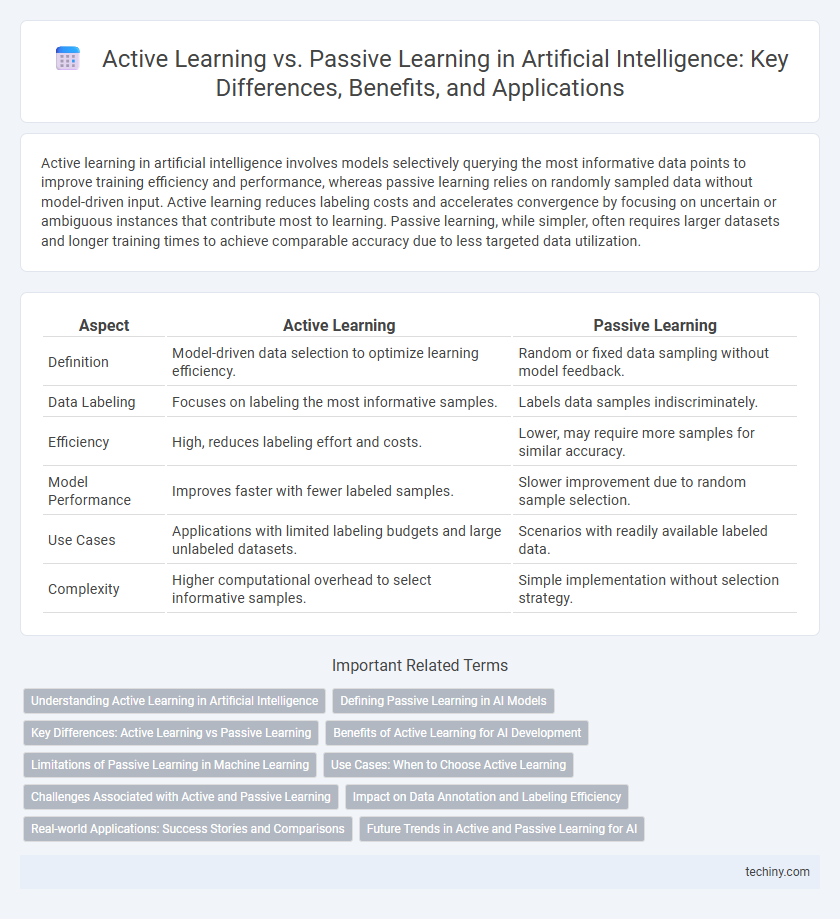Active learning in artificial intelligence involves models selectively querying the most informative data points to improve training efficiency and performance, whereas passive learning relies on randomly sampled data without model-driven input. Active learning reduces labeling costs and accelerates convergence by focusing on uncertain or ambiguous instances that contribute most to learning. Passive learning, while simpler, often requires larger datasets and longer training times to achieve comparable accuracy due to less targeted data utilization.
Table of Comparison
| Aspect | Active Learning | Passive Learning |
|---|---|---|
| Definition | Model-driven data selection to optimize learning efficiency. | Random or fixed data sampling without model feedback. |
| Data Labeling | Focuses on labeling the most informative samples. | Labels data samples indiscriminately. |
| Efficiency | High, reduces labeling effort and costs. | Lower, may require more samples for similar accuracy. |
| Model Performance | Improves faster with fewer labeled samples. | Slower improvement due to random sample selection. |
| Use Cases | Applications with limited labeling budgets and large unlabeled datasets. | Scenarios with readily available labeled data. |
| Complexity | Higher computational overhead to select informative samples. | Simple implementation without selection strategy. |
Understanding Active Learning in Artificial Intelligence
Active learning in artificial intelligence enables models to selectively query the most informative data points, significantly reducing the amount of labeled data needed for training while improving accuracy. This approach contrasts with passive learning, where models are trained on a fixed dataset without feedback, leading to inefficiencies in data utilization. By leveraging techniques such as uncertainty sampling and query-by-committee, active learning enhances model performance and accelerates the development of intelligent systems.
Defining Passive Learning in AI Models
Passive learning in AI models involves training algorithms on pre-labeled datasets without real-time interaction or feedback, relying solely on static data for pattern recognition and prediction. This approach limits the model's ability to adapt to new, unseen data or correct its own mistakes autonomously. Passive learning is commonly used in supervised learning scenarios where the data distribution remains constant and comprehensive labeling is feasible.
Key Differences: Active Learning vs Passive Learning
Active Learning in Artificial Intelligence involves iterative model training using selectively chosen data samples, which improves accuracy and efficiency by focusing on uncertain or informative instances. Passive Learning, by contrast, relies on static, pre-collected datasets without adaptive data selection, often requiring larger volumes of labeled data for comparable performance. The key difference lies in Active Learning's dynamic query strategy that minimizes labeling costs, whereas Passive Learning depends solely on given data distributions.
Benefits of Active Learning for AI Development
Active learning in AI development significantly enhances model accuracy by selectively querying the most informative data points, reducing the need for extensive labeled datasets. This approach accelerates training efficiency and improves generalization by focusing on ambiguous or uncertain samples that passive learning often overlooks. Consequently, active learning minimizes labeling costs while maximizing model performance in complex, real-world scenarios.
Limitations of Passive Learning in Machine Learning
Passive learning in machine learning often suffers from inefficiency due to its reliance on large amounts of labeled data without leveraging the model's uncertainty or knowledge gaps. This approach can lead to slower convergence and suboptimal performance, as it fails to prioritize informative samples that could improve model accuracy more effectively. Consequently, passive learning may require extensive computational resources and time, limiting its scalability in real-world applications where labeled data is scarce or expensive.
Use Cases: When to Choose Active Learning
Active learning excels in scenarios with limited labeled data but abundant unlabeled data, such as medical image annotation or fraud detection, where labeling is costly and time-consuming. It strategically selects the most informative samples to improve model accuracy efficiently, reducing annotation efforts. Passive learning suits well-labeled datasets but often underperforms in domains requiring continuous adaptation or expert input for rare cases.
Challenges Associated with Active and Passive Learning
Active learning faces challenges such as high labeling costs and the need for complex query strategies to select the most informative data points, which can be computationally intensive and require expert intervention. Passive learning struggles with inefficiency, as it relies on randomly sampled labeled data that may not represent the distribution effectively, leading to slower model improvement. Both approaches encounter difficulties in handling noisy or ambiguous data, which can degrade model performance and complicate the learning process.
Impact on Data Annotation and Labeling Efficiency
Active learning significantly enhances data annotation and labeling efficiency by selectively querying the most informative data points, reducing the volume of labeled samples needed for model training. Passive learning, in contrast, relies on random sampling, often leading to redundant annotations and increased time and cost. This targeted approach in active learning accelerates model improvement and optimizes resource allocation in AI development projects.
Real-world Applications: Success Stories and Comparisons
Active learning enhances model performance by iteratively selecting the most informative data points for labeling, reducing annotation costs and improving accuracy in real-world applications like medical image analysis and autonomous driving. Passive learning relies on randomly labeled datasets, often requiring larger volumes of data and higher computational resources, which can limit efficiency in dynamic environments. Success stories in natural language processing and fraud detection demonstrate active learning's superior adaptability and faster convergence compared to passive learning strategies.
Future Trends in Active and Passive Learning for AI
Future trends in active learning for AI emphasize adaptive querying strategies that maximize model improvement with minimal labeled data, enhancing efficiency in complex tasks such as natural language processing and computer vision. Passive learning, while reliant on large-scale static datasets, continues to evolve through integration with unsupervised and self-supervised techniques that improve representation learning without explicit labeling. The convergence of these approaches promises hybrid frameworks where active learning refines models on critical samples while passive learning leverages vast unlabeled data, accelerating AI development and application scalability.
Active Learning vs Passive Learning Infographic

 techiny.com
techiny.com